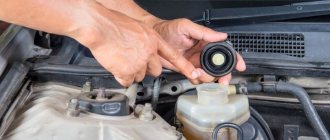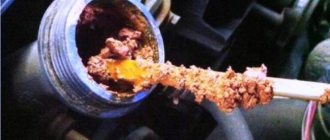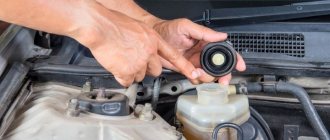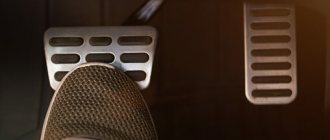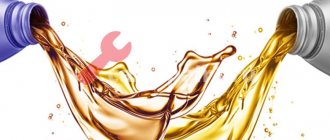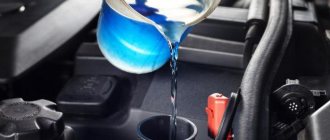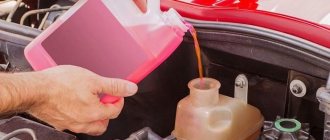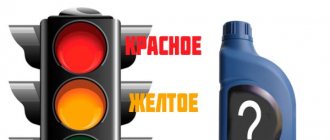Every car owner has at least once had the question of what would happen if you mixed several coolants of different brands. And also is it possible to mix antifreezes of different colors, how blue differs from red and similar thoughts. We will consider these and other questions below so that the reader does not use chemicals in the garage and damage his car.
It is worth noting that, subject to certain conditions, some antifreezes can be mixed. If you do not comply with them, you are guaranteed to “kill” the radiator in two to three years. And it will not be possible to restore it. Therefore, you should think carefully before exposing your car to such a risk.
Composition of antifreeze
Any liquid contains an 80% mixture of distilled water and ethylene glycol. The remaining 20% comes from various types of additives that impart special characteristics to a particular liquid. This applies to standards G11 and 12.
Additives are a key aspect of any formulation. They are needed to neutralize the destructive effect of water and ethylene glycol on the metal parts of the cooling system, in particular the walls of the tubes and radiator.
All additives can be divided into two main types:
- Protective - protect pipes and other elements from aggressive influences by forming a thin layer in the form of a film. Used in antifreeze and antifreeze brand G11.
- Anti-corrosion – neutralize rust during operation or slow down its negative impact. Such additives are more often used in G12 and G12+.
In addition to these, there is another type of additives - hybrid (G13). They combine chemical elements of both categories. Therefore, they are considered universal and suitable for topping up. But not always!
Dilute correctly
The cooling system should not be allowed to operate on several different antifreezes at once. If two or more species are mixed, the composition must be taken into account. It is important that the liquids have a similar base. Mixing any brands is allowed, although this is not recommended and only applies to high quality products. Refrigerants belonging to the G11 standard can be diluted with any antifreeze except G12. As for G12 fluids, they can only be mixed with similar refrigerants or with products that fall under the G12+ standard. You cannot mix with substances of another class.
G13 refrigerants can be diluted with G12+ and G12++ fluids. Mixing antifreeze with domestically produced antifreeze, which is considered a more aggressive agent for many imported cars, is not allowed. Because these products have fundamentally different bases. We have figured out why it is impossible to mix refrigerants of different compositions; special mention should be made about dilution with water.
If you have detected a lack of liquid in the OS, then you can replenish the volume with distillate, but this is only allowed in the warm season. In cold weather, adding water can cause it to freeze in the cooling system, which will negatively affect the functionality of the elements. Do not use tap liquid for mixing, as the composition contains substances that will lead to the formation of rust and scale. As a result, this will cause clogging of the highways. In cold weather, it is not worth adding water to the concentrate, since it is usually at least 65% in any refrigerant.
What do different colors of antifreeze indicate?
As everyone knows, antifreezes differ not only in composition, but also in color. But not everyone can answer the question of what this means. Oddly enough, but first of all, color is needed to quickly distinguish it from plain water. Without dyes, antifreeze is transparent, and because of this it can easily be confused with distilled water, which cannot be used in cold weather.
Bright colors make it recognizable. If a leak appears in the cooling system, it will be immediately noticeable. So, in essence, the color does not indicate the contents of the coolant.
Video “How to properly flush the cooling system?”
User Lesha Master published a video in which he showed the cleaning process and explained all the nuances of performing this task.
Do you have any questions? Specialists and readers of the AUTODVIG website will help you ask a question
Was this article helpful?
Thank you for your opinion!
The article was useful. Please share the information with your friends.
Yes (62.50%)
No (37.50%)
X
Please write what is wrong and leave recommendations on the article
Cancel reply
Rate this article: ( 8 votes, average: 4.63 out of 5)
Discuss the article:
Antifreeze classification
The most common are six brands of coolants. These include: antifreeze, G11, G12, G12+, G12++, G13. They are manufactured by different companies and may differ in color and concentration. It is important to note here that shades of antifreeze cannot act as a criterion when selecting a new one. Even with identical composition, coolant from different manufacturers may not match in color.
Differences between antifreezes of different classes:
- Antifreeze - produced in the USSR as a replacement for foreign coolants. Consists of distilled water and ethylene glycol with various additives. They come in green, blue and other colors.
- G11 is a classic antifreeze. The base composition includes ethylene glycol, water and additives (salts of certain acids, borates, nitrites, etc.). It has a long service life. Mostly blue.
- G12 – carboxylate antifreeze. The composition is similar to the previous one, but they additionally contain carboxylic acid compounds. They have a longer lifespan and are available in pink and red colors.
- G12+ is a mixture of water, ethylene glycol and additives (based on carboxylic, silicon, nitric and phosphoric acids). The components that make up such liquids may differ, depending on the manufacturer. Most often produced in red.
- G12++ also refers to hybrid antifreeze. For their production, an organic base and silicic acid compounds are used. The properties are similar to the previous type, and their main difference is their long service life. Available in red and sometimes yellow colors.
- G13 is a relatively new antifreeze. Its base, instead of ethylene glycol, is harmless propylene glycol. Colored in pink or purple shades.
Although the color of antifreeze serves more of a decorative function, it still has weight when choosing a liquid for the cooling system.
The consequences of mixing yellow and green
We have already found out whether it is possible to add antifreeze of the same brand and what the consequences are, but is it possible to mix red (green) and yellow antifreeze? But here the consequences will be dire.
Green (also known as red and blue) is a coolant based on ethylene glycol and distilled water. The yellow (purple) liquid consists of propylene glycol, and this is a significant difference. Is it possible to mix these antifreezes? Absolutely not.
Ethylene and propylene are different types of alcohol, albeit monohydric. Another thing is that the first one is toxic, and in the second case this flaw was removed. Let's add 2 types of additives to G13. We get the following picture:
- we have no idea how alcohols react with each other and how dire the consequences are;
- the additives in G13 are designed specifically for propylene glycol, so no one can say how they will behave in “foreign” elements;
- no one will give a confident answer about the compatibility of antifreeze.
Remember that the universal donor is not G13, but G12++. It is written above in detail which antifreezes can be mixed without consequences.
Read the composition of the product very carefully and never skimp on coolant. Car repairs will still cost more, especially major ones. Not the smartest way to keep money in your wallet.
Is it possible to mix antifreeze with antifreeze?
Previously, the domestic market could only offer the buyer antifreeze from coolant, so everyone poured it into cars. Now antifreeze is widely used. In this regard, when on forums and in thematic chats people are interested in the possibility of mixing different antifreezes, they often mean antifreeze and antifreeze. Many car enthusiasts think that by combining two different compositions they will get a product with the advantages of the first and second liquid.
Car service specialists claim that mixing antifreeze and antifreeze will not improve the quality and properties of the composition. However, there are situations (especially on long trips) when it is urgently necessary to add coolant to the system, but it is not possible to obtain antifreeze of the same composition as the one that was filled in. Then mixing some brands of antifreeze and antifreeze is allowed, especially if the air temperature drops to zero.
However, after such a procedure, as soon as possible, you will need to drain the mixture, flush the cooling system and add fresh antifreeze.
What happens if you mix green, red, yellow (purple) antifreeze from different manufacturers?
YES, in fact, nothing will happen, you can pour and not even be afraid, if they maintain their standard, then ABSOLUTELY NOTHING TERRIBLE WILL HAPPEN. Such questions arise when, say, your branded antifreeze has run out, there is nowhere to buy it (for example, you are on a trip), and red ones from another manufacturer are sold.
So G11 green (from one manufacturer) can be mixed with G11 green from another manufacturer. The main thing is that the standards are similar.
As you may have guessed, G12 can be mixed with G12 from another manufacturer.
The same can be done with G13, that is, pouring yellow into yellow or violet into violet.
Is it possible to mix antifreeze of different colors?
More often, antifreezes that have different colors also differ in characteristics. It's all about the additives used, which have their own shades. New brands of liquids differ from old auto chemicals in their environmental friendliness. On store shelves you can find hybrid, carboxylate, labrid and other formulations. Their difference is not only in colors, but also in composition, as well as performance characteristics.
As noted earlier, various additives give them their properties. It should be noted that mixing antifreezes of different shades, even if they are of the same type, but produced by different manufacturers, is extremely undesirable. The fact is that additives included in the liquid can react, which will lead to neutralization of their beneficial properties.
Let us remind you that mixing them is permissible only in very extreme cases. For example, G13 antifreeze poured into new cars can be combined with other liquids, but its anti-corrosion properties are significantly reduced. No matter what ratio G13 is mixed in, the resulting coolant will still be of significantly worse quality. That is, when combining G11 and 13, you get a liquid with the characteristics of the first antifreeze. In addition, prolonged use of the mixture can cause irreparable damage to the car.
About color
The color of antifreeze is more of a distinctive component. As a rule, now it does not carry any semantic load. Although many manufacturers, including Volkswagen, tried to introduce color differences between antifreezes, they even had their own recommended colors.
So G11 was almost always green.
G12 – red (or bright orange)
G13 – purple
Although many manufacturers now do not follow the path of Volkswagen and paint antifreeze in the colors they please, this is because there is no strict standardization. So G11 can be either blue or reddish. G12 – green. And G13 is not only purple, but also yellow .
Colors were introduced so that the driver could easily and simply distinguish between antifreezes, but the confusion between manufacturers is now increasingly confusing the common man.
Is it possible to mix antifreezes with different properties?
When figuring out whether it is possible to mix coolants with different properties with each other, it is worth remembering that G11 and G12+ belong to the same class, and G13 has a completely different composition. A cocktail of G11 and 12+ will retain its protective and anti-corrosion properties, but it should be taken into account that the mixing procedure is difficult to control. In addition, it is not possible to determine in advance what composition of additives will be obtained at the output. It is also worth understanding that by mixing different liquids, you can end up with a combination that includes additives that are undesirable for a given model of engine and radiator. Which will lead to a decrease in the performance of the entire cooling system of the car.
The fact is that G11 antifreeze forms a protective layer on the inner wall of the pipes, which has a positive effect on the cooling process of the engine and all its elements. When mixing blue or green liquids with red, the temperature regime of the motor may be disrupted. However, when adding a small amount of antifreeze with other properties (for example, 0.5 l or less), the changes may be subtle.
Types of antifreeze and their features
To understand whether it is possible to mix antifreeze, you need to better understand the physical and chemical processes that accompany the processes of mixing the mentioned liquids. All antifreezes are divided into ethylene glycol and propylene glycol. In turn, ethylene glycol antifreezes are also divided into subtypes.
In post-Soviet countries, the most common specification by which antifreezes are distinguished is a document issued by Volkswagen, and has the code TL 774. In accordance with it, antifreezes used in cars of this brand are divided into five types - C, F, G, H and J. The same encoding is commercially designated as G11, G12, G12+, G12++, G13. This is exactly how car enthusiasts most often choose antifreeze for their car in our country.
There are also other specifications released by various automakers. For example, General Motors GM 1899-M and GM 6038-M, Ford WSS-M97B44-D, Komatsu KES 07.892, Hyundai-KIA MS591-08, Renault 41-01-001/-S Type D, Mercedes-Benz 325.3 and others .
Different countries have their own standards and regulations. If for the Russian Federation this is the well-known GOST, then for the USA - ASTM D 3306, ASTM D 4340: ASTM D 4985 (antifreeze based on ethylene glycol) and SAE J1034 (based on propylene glycol), which are often considered international. For England - BS6580:1992 (almost similar to the mentioned G11 from VW), for Japan - JISK 2234, for France - AFNORNFR 15-601, for Germany - FWHEFTR 443, for Italy - CUNA, for Australia - ONORM.
So, ethylene glycol antifreezes are divided into several more subtypes. In particular:
- Traditional (with inorganic corrosion inhibitors). According to Volkswagen specifications, they are designated as G11. Their international designation is IAT (Inorganic Acid Technology). Used on machines with older types of engines (mainly those whose parts are made largely of copper or brass). Their service life is 2…3 years (rarely longer). These types of antifreeze are usually green or blue. Although in fact, color does not directly affect the properties of antifreeze. Accordingly, one can only partially focus on the shade, but not accept it as the ultimate truth.
- Carboxylate (with organic inhibitors). Volkswagen specifications indicate VW TL 774-D (G12, G12+). As a rule, they are marked with a bright red dye, less often - lilac-violet (VW specification TL 774-F / G12+, used by this company since 2003). International designation: OAT (Organic Acid Technology). The service life of such coolants is 3…5 years. A special feature of carboxylate antifreezes is the fact that they are used in new cars that were initially designed only for this type of coolant. If you plan to switch to carboxylate antifreeze from an older one (G11), then you must perform the procedure of flushing the cooling system first with water and then with a concentrate of the new antifreeze. You should also replace all seals and hoses in the system.
- Hybrid . Their name is due to the fact that such antifreezes contain both salts of carboxylic acids and inorganic salts - usually silicates, nitrites or phosphates. As for color, there are a variety of options available, from yellow or orange to blue and green. International designation: HOAT (Hybrid Organic Acid Technology) or Hybrid. Despite the fact that hybrid ones are considered worse than carboxylate ones, many manufacturers use just such antifreezes (for example, BMW and Chrysler). In particular, the specification of the BMW N600 69.0 is largely the same as the G11. Also for BMW cars the specification GS 94000 applies. For Opel - Opel-GM 6277M.
- Lobrid (international designation - Lobrid - Low hybrid or SOAT - Silicon enhanced Organic Acid Technology). They contain organic corrosion inhibitors in combination with silicon compounds. They are the most modern and have the best performance characteristics. In addition, the service life of such antifreezes is up to 10 years (which often means the entire life of the machine). Meets VW TL 774-G / G12++ specifications. As for color, they are usually red, purple or lilac.
However, the most modern and advanced today are antifreezes based on propylene glycol. This alcohol is safer for the environment and humans. It is usually yellow or orange in color (although there may be other variations).
Years of validity of various standards by year
Is it possible to mix antifreeze of different brands?
Coolant of different brands can be mixed, provided that they have a similar composition and are also included in the same group. If you are not sure that the parameters of the added and used antifreeze are similar, then you should not put the cooling system at risk.
By mixing liquids of different compositions, you can get a negative reaction. Namely:
- Deposits may appear in the cooling system, leading to the formation of a mixture with even lower performance properties. Additives in different brands of antifreeze may react. The consistency of the coolant may change, for example, thicken, which will lead to a deterioration in its circulation through the system. This leads to clogged pipes and overheating of the motor lubricant and the engine itself. To fix this problem, you will need to completely drain the liquid, replace the pipes, flush the system and fill it with fresh antifreeze.
- Substances from different brands of antifreeze, when mixed, can neutralize each other's work. If a situation arises where you still have to mix them, you will definitely need to drain the mixture, rinse the pipes and radiator. Then add fresh antifreeze.
- When mixing coolants of different compositions, the likelihood of antifreeze foaming increases. Foam accumulates in the expansion tank and system pipes. The situation cannot be corrected by adding anti-foam additives. The intervention of car service specialists will be required to flush the system, after which you need to fill in fresh coolant.
Excessive clogging of the cooling system pipes leads to the following consequences:
- bearings wear out quickly;
- the pump overheats and fails;
- overheating of the cylinder head and other engine components, which leads to its deformation and destruction.
That is, the consequences of mixing can be extremely serious, therefore, you should not expose your car to such a risk. And if such a need arises, the composition of the coolant should be taken into account.
Is it possible to mix different standards?
Here the situation is more interesting. If antifreeze of different colors, but of the same group, can be interchanged, then different products can cause unexpected reactions in the system, only aggravating the situation of your radiator and other components of the cooling system.
Is it possible to mix antifreeze of different subgroups? You need to understand that G11 and G12 have completely different additives: the former are aimed at creating a film, the latter at eliminating rust. It is almost impossible to control the mixing of active components. Yes, sediment may not fall, but the film will significantly reduce the cooling efficiency. This is because green antifreezes reduce the diameter of pipes and other components. The temperature drops, as do the cooler characteristics. A kind of “thrombus” may even form, which can cause the radiator to fail.
It all depends on the final volume of the diluent liquid. If you pour up to half a liter, then there will be no consequences. But in the future you need to fill in the “native” cooler.
Several rules for mixing antifreeze
As already noted, different antifreezes differ in composition and have different additives. Most liquids are prohibited from mixing with each other, as this leads to the appearance of sediment and an increase in the thickness of the liquid.
However, some coolants can still be mixed without negative consequences. The question remains: is this necessary? Such a mixture will not cause any particular harm, but if this can be avoided, then there is no need to mix anything. In the worst case scenario, the resulting fluid will not work for long, and can even harm the engine.
Recommendations for mixing individual brands of coolants:
- Do not under any circumstances mix G11 class antifreezes with G12;
- it is allowed to mix liquids with compositions G11 with G12+ and G13;
- in case of emergency, you can mix G12 coolant with G12+;
- It is not recommended to combine G12 fluids with G12++ or G13;
- G12+, G12++ and G13 can be mixed with each other;
- Under no circumstances should antifreeze and any antifreeze be mixed.
Naturally, in an emergency situation, it will be quite difficult to remember what you can mix with, but this will help to avoid negative consequences. When deciding on mixing, you should focus primarily not on color, but on the chemical composition. In addition, do not forget about the presence of a large number of counterfeits on the modern car chemical market. It is simply impossible to predict the consequences of mixing antifreeze with counterfeit liquid.
It is quite difficult for car owners to understand the shades of modern antifreezes. Antifreeze is replaced approximately every two to three years. After replacing the old coolant with a new one, the car owner is not interested in this type of product for a very long time. And during this period, manufacturers can change a lot in the classification and standards of their products. It will also not be possible to purchase antifreeze in large quantities, since it has a certain shelf life.
To avoid mistakes, when purchasing coolant, you should give preference to one manufacturer. It is also a good idea to study the composition of the antifreeze being poured; it is indicated on the packaging.
Antifreeze mixing table
Different types of coolant
First you need to understand what antifreezes are and what they are.
Due to the use of different base components and additive packages, coolants can differ greatly in chemical composition. Their colors may also vary.
Additives are divided into two large categories and perform two main functions - protective and anti-corrosion.
This classification became quite popular and was accepted by the pan-European community. However, it is not mandatory for all manufacturers. And if division according to operational characteristics is still actively used, then the color of the dye can vary significantly. Therefore, you can find other options for class-color combinations on sale.
In the 70s of the 20th century, the Volkswagen automobile concern classified coolants depending on their purpose, composition and set of operational properties into the following main classes:
- G11 - coolant based on ethylene glycol with the addition of an additive package of inorganic origin (usually silicate based). Volkswagen assigned green color to this class
- G12 - these materials are also made on the basis of ethylene glycol, but organic additives are added to them (usually carboxylate compounds)
- Silicate and carboxylate technologies have their pros and cons. It was possible to combine their best properties by using hybrid additives of organic and inorganic origin in one composition. These coolants received class G12+
- In 2008, another class of G12++ coolants appeared, in which organic-based additives form a special package with a small amount of mineral components
- G13 – coolant with organic carboxylate additives, but based on harmless polypropylene glycol
For this reason, drivers are interested in the question: if the compositions and colors of antifreeze are so diverse, then how miscible is antifreeze? Will the types and differences in chemical composition cause any harmful consequences for the cooling system and engine?
How to check antifreeze compatibility
It is easy to find out the compatibility of various coolants even at home or in the garage. True, this method will not give one hundred percent confidence that after mixing two antifreezes, the composition will work normally and perform its functions in the car.
The method is as follows. It is necessary to take a sample of the liquid that is poured into the cooling system and mixed in a separate container with the one that is planned to be added. You can take a sample using a syringe from the expansion tank or use the drain hole.
After receiving a sample of antifreeze from the car, pour it into any, preferably transparent, container and add to it approximately the same amount of coolant that you want to add to the cooling system. Leave the mixture for 5 – 10 minutes.
If mixing did not lead to a violent reaction in the container, foam did not appear on the surface of the composition, or sediment fell to the bottom of the container, then most likely the antifreezes are compatible with each other. If at least one of the listed reactions is detected, it is strongly recommended to avoid mixing such antifreezes. To make the test more accurate, mixed liquids can be heated to 80 - 90 °C.
Is it permissible to mix different colored coolants?
There are no hard and fast rules allowing or prohibiting the mixing of refrigerants with different shades. In many cases, it is possible to interfere with the coolant, but there are also situations when this is prohibited.
Please note that in most cases the following color binding applies:
- G11 - green, blue;
- G12 /12+ / 12++ - pink, red;
- G13 - orange, yellow.
Let's look at the situation in more detail using examples.
Red with green
As noted, red coolant can refer to G12 / 12+ / 12++, and green coolant to G11. There are two steps involved in identifying an opportunity. Firstly, make sure the refrigerant matches the selected class, and secondly, look at the color. In simple words, mixing red G12 and green G11 is prohibited.
Red with yellow
There are no prohibitions here, because, most likely, you have to combine G13 and G12, which is not prohibited.
Red with red
Coolant types G12 / 12+ / 12++, which have a reddish tint, are allowed to be mixed without risk. But you should be careful in a situation where the product is produced by different companies. In such circumstances, mixing is not advisable due to the different composition of the additives and the differences in the technologies used. Those. It's 50/50, depending on your luck.
Tips for topping up coolant
To conclude the article, we will provide several recommendations regarding adding antifreeze to the cooling system.
Basic points:
- To add/mix coolant, use one container. For example, you buy a large canister and pour a certain volume into the engine cooling system. In the future, you store the container in the luggage compartment or at home, and top it up if necessary. When the top-up fluid runs out, it is advisable to flush the system and add new antifreeze.
- When using a car with a copper/brass radiator and an engine with cast iron blocks, fill the system with G11 (green or blue). As a rule, the recommendation applies to domestic VAZ cars.
- For short-term use, any antifreeze can be mixed. The only exception is TOSOL, which must be used separately. Also, avoid using G11 and G together. This is due to the characteristics of the composition and the dangerous chemical reactions that can occur inside. Once mixed, the resulting coolant loses efficiency and/or destroys the rubber elements in the system.
- If you had to mix different types of antifreeze, do not drive the car for a long time. If possible, immediately flush the system and replace the coolant recommended by the vehicle manufacturer.
- In extreme situations, when you do not know the type of refrigerant filled, and the level has dropped below the permissible level, add distilled water (up to 0.2 l) or G12+ antifreeze. These liquids can be mixed with all types of brands.
- For aluminum or "alloy" engines, which are found in most modern cars, use G12 or G12+ in orange/pink shades. For new cars, more advanced antifreezes of class G13 or G12++ are recommended. Detailed information can be obtained from the car's operating instructions.
Following the recommendations discussed above allows you to extend the life of the motor and avoid premature repairs.
Universal antifreeze from Sintec
To avoid possible mistakes when mixing different coolants, it is worth using the universal MultiFreeze composition. This is a unique development by Sintec, which is gaining wide popularity among car enthusiasts. Multifreeze has a hybrid chemical composition and is manufactured using a special technology. This liquid is fully interchangeable with antifreeze of all brands, including G11, G12, G12+, G13 and others. The color of the initial composition, which is present in the system at the time of refilling, does not matter. The compatibility of multifreeze with other classes of coolants has been proven in laboratory conditions and in real tests.
What can happen when mixing different compounds?
It is not recommended to mix different categories of antifreeze, as this can lead to negative consequences:
- formation of sediment , which will have an abrasive effect on the nodes;
- decreased thermal conductivity of the coolant;
- narrowing of antifreeze operating temperatures;
- clogging of the internal systems of the car with sediment and deterioration of circulation;
- formation of foam , which comes out through the expansion tank;
- corrosion of seals;
- overheating of the engine, especially in the summer;

